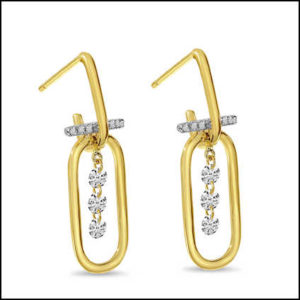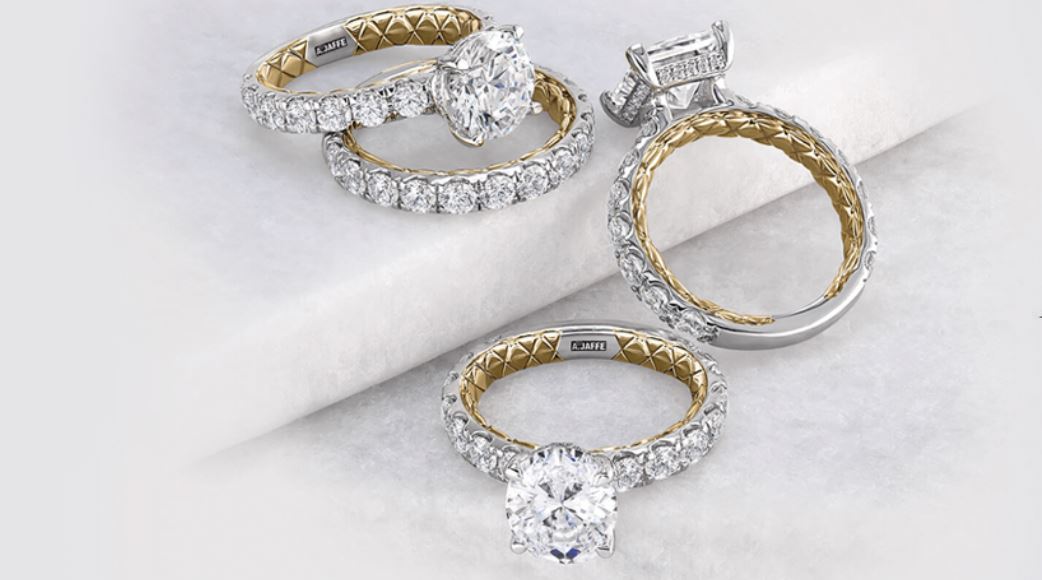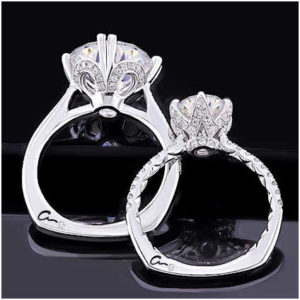Savvy Jewelers Build Their Own Brand Equity
In today’s competitive marketplace, savvy retail jewelers set themselves apart from the competition by creating their own authenticate brand to insulate against the unyieldingly severe forces of competition that all businesses face today.
A branded retail store creates a lasting impression in the minds of the consumers, and the differentiation goes beyond the descriptive rendering of a brand, extending to the emotional connection and passion a store instills in its customers.
“It’s a powerful emotional connection, established by the entity, that sets it apart from its competition,” says Sam Sandberg, chairman of A. Jaffe, who conducted a Plumb Club podcast on the topic, “Strategies to Brand as an Independent Jeweler.” “A brand is a set of distinct characteristics that establishes a recognizable image or identity. Brands define the business. Brands define intent. Brands define what is to be trusted. Brands harness the power of emotions and subliminal needs and desires.”
Sandberg pulls his expertise from his 30 years of working directly with 250 independent jewelers for a brand whose legacy dates back to 1892 (one of the only 19th century jewelers still active in New York City). He has seen that jewelers who’ve developed brand equity stand apart from their competition. Brand value is a huge component of a business’ equity value.
The retailer’s challenge, Sandberg says, is one of demand creation. “People don’t need the things we’re selling. As a result, a brand stands for all the abstractions we impart on this purchase and our lives as a whole. Who do I want to be? How do I want to feel? Who do I want to align with? Does this purchase advance my personal values? The product has to support the narrative, but the narrative is the driver’s seat.”
In a Word
The reigning global brands for which we are all familiar each own a word that rests in the minds of the public, Sandberg cites; Apple and invention, Mercedes and engineering, Nike and inspiration, Chanel and luxury, Rolex and success.
Independent jewelers that have achieved brand recognition are connected to a word that triggers a perception — words like luxury, expertise, legacy, selection, and trend. In his podcast, Sandberg breaks down how this looks for jewelers:
Luxury-branded jewelry stores create a five-star grand hotel experience for their customers. Every element conveys luxury, including valet parking, décor, lighting, exquisitely printed and bound catalogues and brochures, Dior-level website, and global brands exclusive to the jeweler. Private shows are common and group events take place at prestigious venues like elite galleries and fine restaurants. Partnerships outside the jewelry industry for such jewelers might be with leading cultural non-profits in the community.
 Expertise-branded jewelry stores have multiple jewelers, watch repairers and gemologists on staff, professionally trained and certified by the most respected trade institutions and passionate to educate consumers. Prominently displayed in the store are diplomas, awards and accolades. The website links to information on educational sites like GIA, AGS, FIT, and master classes such as diamonds, from crystals to gems, feature prominently. Non-profit affiliations might include Diamonds Do Good, Mercury Free Mining, and Jewelers for Children.
Expertise-branded jewelry stores have multiple jewelers, watch repairers and gemologists on staff, professionally trained and certified by the most respected trade institutions and passionate to educate consumers. Prominently displayed in the store are diplomas, awards and accolades. The website links to information on educational sites like GIA, AGS, FIT, and master classes such as diamonds, from crystals to gems, feature prominently. Non-profit affiliations might include Diamonds Do Good, Mercury Free Mining, and Jewelers for Children.
Legacy-branded jewelry stores have history as their cornerstone and are prominent fixtures in their community over multiple generations. Visitors might find heirlooms like portraits, framed news articles, memorial showcases, and memorabilia that tell the jeweler’s history, as past and present co-exist. The website likely offers timelines of milestones, as well as fine jewelry popular over the years, and long-term partnerships with legacy brands. Part of its identity is likely partnerships with community groups like the Rotary Club, Small Business Association, YMCA/YWCA, Goodwill, and houses of worship.
Selection-branded jewelry stores are staffed with a range of sales associates and buyers focused on serving different demographics expertly. The sales staff is extremely approachable and relatable. All popular product categories are prominently displayed and replete with proven bestsellers. Styles in high demand are always in stock. The website makes available additional styles that can be special ordered for quick delivery. Hologram technology and iPads allow for deeper product presentation, quick pricing quotations, and fast special ordering.
Trend-branded jewelry stores are driven by energy, fun and outside the box thinking in product, store design, lighting, showcase and window technology, and media. A trend-driven store seeks out hot designers and categories, as well as traditional products and categories from established trendsetting designers. Events are creative, festive, and in cool venues. Just browsing is as common as buying for both repeat and first-time visitors. The website mirrors the on-trend experience in store. Likely community affiliations are organizations such as the Gate’s Foundation, American Red Cross, and Doctors Without Borders.
Emotional Triggers
People buy emotionally, even if they justify their decisions rationally, explains Pam Levine, brand experience specialist and president of Levine Luxury Branding, who shared her perspectives in a Plumb Club podcast on visual merchandising. “We can trigger these buying emotions by the ways we present and display products.”
Levine encourages jewelers to consider what makes their store unique. “Take a moment to write down what you want your customers to believe and feel about your store. Does your store express your brand today? Are you clear about the impression your store leaves in the hearts and minds of your customer?”
Many of the brands Levine works with, from Cartier to Tiny Jewel Box, have incredibly strong brands that clearly make a promise to the customer. “When we work with our clients on branding, we make sure that the promise and personality comes through every place their brand interacts with a customer in a welcoming and engaging manner,” she explains. “That means their store, displays, website, advertising, packaging, tone of voice conveys a consistent brand message.”
Brand Alignment
Savvy jewelers work closely with the brands they align with to reinforce their values and increase the opportunities to drive customers to their store.
“Each brand handles their PR and messaging slightly different, but the end goal is to drive traffic to your store,” explains Jordan Peck, COO of Brevani, who has shared insights for jewelers on branded content in a Plumb Club podcast.
Promoting the PR initiatives of the brands a jeweler carries will increase the store’s exposure. Brevani shares social media content with its retailers, including corresponding styles in hi-res images. Many of its pieces have been featured on The Bachelorette and when the show airs, the brand posts about it for retailers to share. “Since retailers tag us, the bachelorette, and the show, the store’s reach is broader, and many have gained followers specifically from this initiative.”
Peck underscores that this exposure directly impacts purchases at retail, creating buzz around the brand, and ultimately jewelers will have customers interested in specific products. He encourages jewelers to be proactive in their planning and scheduling of social media posts, ads, in store promotions, and communications to line up with brand PR opportunities. It’s a great way to improve the brand retailer experience, and most brands want to partner with their retailers.
“Speak with the brands you work with and find out what they have planned for PR throughout the year,” suggests Peck. Most will be thrilled to have that discussion with you and get you the content you need so you can plan promotions, sales, in store giveaways, trunk shows, or even just schedule your ads or social media posts to coincide with the social events around you that will engage customers and drive traffic into the store.”
Peck encourages jewelers to tell their vendors what they need. “You know what your customers want, so tell the brands you work with what you need from them to make the sale happen,” he says, citing things like pre-built and custom marketing materials, social media images, and in store posters and in case displays. “Make a checklist of what you need and request it from your vendors. Most of the time, they will have what you need ready to go and happy to share it.”
The best thing jewelers can do for their store is to get custom marketing materials from the brands they work with that have the store’s logo and styles actually found in their showcases. “Get banners, eblasts, postcards, magazine ads whatever you need geared to you and your customer base and find out how quickly you can get the material, so you know when to request it,” shares Peck.
Brand partners underscore the jeweler’s brand message and values, as Valerie Fletcher, vice president of design and product development for Original Design Inc. (ODI) has seen with its branded LoveFire Greenland Ruby and Polar Pink Sapphires from Greenland — the world’s oldest gem deposit, and the only one that is 100% assured to be conflict free and tracked from mine to jewelry.
In addition to assets including displays, brochures, Instagram-ready images and copy, and sales training manual, the brand has a new interactive QR code on the back of the card of authenticity that comes with each gem that engages customers to learn about the provenance of their stone right on their phone, Fletcher says. Moreover, every purchase helps to support the PinkPolarBear Foundation, which benefits the community surrounding the mine-site.












